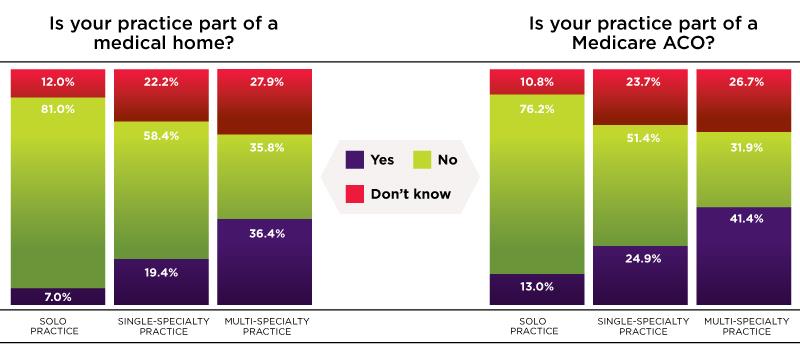With little data available on the prevalence of new models of care delivery and payment, you may be wondering whether any of your peers actually are participating. Learn which practice types have adopted these new models and which are still contemplating the transition.
A new AMA report (log in) presents a national perspective on physician participation in medical homes and Medicare accountable care organizations (ACO), using data from the AMA’s 2014 Benchmark Survey. Based on information gathered from post-residency physicians who provided at least 20 hours of patient care per week, the report assessed the extent to which alternative payment models (APM) have taken hold across the country.
Here are four key takeaways from the report:
- Participation in medical homes and ACOs varies with practice type. In 2014, 23.7 percent of physicians were part of a medical home, while 28.6 percent were part of a Medicare ACO. Participation varied across practice type, specialty and practice ownership.
- Many physicians are unaware if they are part of a medical home or ACO. For both medical homes and ACOs, almost 25 percent of physicians did not know their practice’s participation status. Not surprisingly, different levels of uncertainty among physicians corresponded with practice type. Physicians in solo practice expressed less uncertainty than those in single specialty practices, while physicians in multi-specialty practices expressed higher levels of uncertainty. These differences relate to the characteristics of physicians in those practice types, such as age, tenure in the practice and whether physicians tend to be owners or employees.
- Ownership structure plays a role in practices that are part of a medical home or ACO. Participation in a medical home was twice as likely among physicians in single specialty practices that were hospital-owned (31.4 percent), compared to practices that were physician owned (14.9 percent). In the same fashion, more participation in ACOs was found among physicians in single specialty, hospital-owned practices (36.0 percent) than among physicians in single specialty, physician owned practices (21.7 percent).
- Well over half of physicians are using APMs. In 2014, 59.0 percent of physicians worked in practices that received payment through at least one APM. Although participation in APMs is growing, very few physicians report that their practice has eliminated the fee-for-service payment structure. The report shows that fee-for-service revenue shares steadily decrease with the number of APMs in use. For example, physicians in practices with only one APM reported that 72.5 percent of practice revenue came from fee-for-service. In practices that received three or four APMs, fee-for-service accounted for less than half of practice revenue.
Interested in adopting new payment models?
As new delivery and payment models become an increasingly critical part of today’s health care environment, the AMA worked with Harold Miller at the Center for Healthcare Quality and Payment Reform to develop the “Guide to physician-focused APMs” to help physicians make decisions about which models will best fit their patients and practices.
Read about the two most common barriers of current payment systems that often stand in the way of implementing changes and learn ways physicians are working to overcome these barriers.




